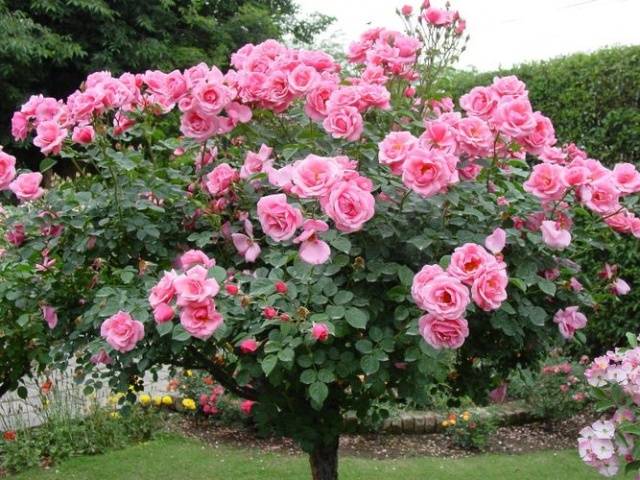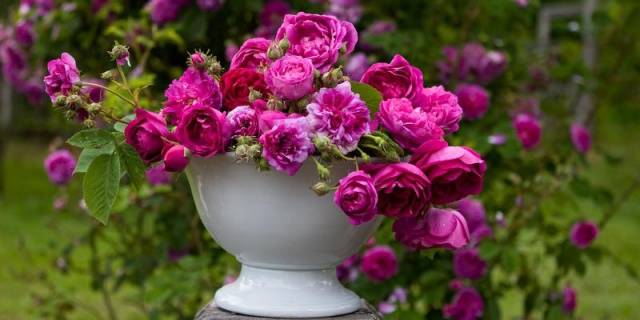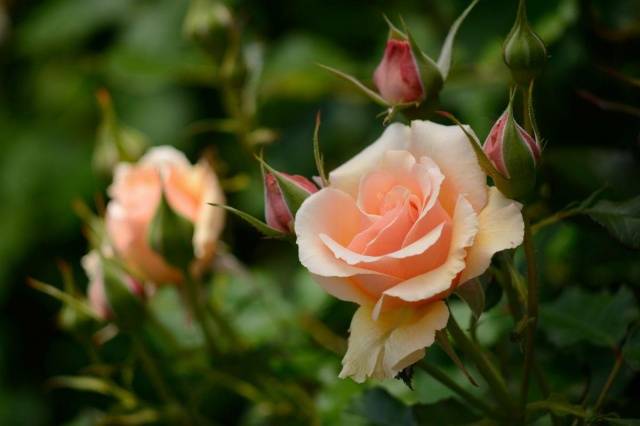Content
Roses have been grown for decorative purposes for more than 5 thousand years. Over such a period of time, people have become so fond of the plant that it is difficult to imagine flower beds without beautiful and delicate roses. From the point of view of archaeologists, the rose has been a wild flower for millions of years. Later it began to be grown in all corners of the earth. Breeders were able to develop hundreds of varieties, differing in shape and color.
According to rough estimates, garden roses include from 200 to 400 varieties, which, in turn, are divided into 40 different types. They are distinguished not only by the appearance of the flowers, but also by the structure of the plant itself. Roses can be bush or have only one straight stem, dwarf or tall, creep along the surface of the ground or curl on a support. Also, each flower has its own special aroma or does not have it at all. And the variety of colors is simply amazing; they can be monochromatic or combine several colors, bright or pastel. Such a large selection allows you to design a flower garden to suit every taste. Some types of garden roses are quite popular in our area, while others are just appearing in stores and in gardeners' flower beds. It is worth taking a closer look at each of them, as well as seeing their features and photos.
Hybrid tea roses
This species includes a large number of varieties. The hybrid tea species first appeared in 1867 through random crossing. Subsequently, breeders managed to develop flowers of various colors, differing in the shape and size of the bud.
These plants are low, erect bushes with large leaves. The height of the bushes may vary depending on the variety, on average from 60 cm to 80 cm. The size of the flowers is average, from 10 cm to 12 cm in diameter. They can be solitary or collected in inflorescences. The flowers are goblet-shaped, and the young buds are elongated and sharp.
Flowering lasts about a month, after which there is a 15-day break for early varieties, and a 30-day break for late varieties. Next, the bush begins to bloom again. New buds form until mid-autumn.
Ground cover species
This variety of garden rose was bred in the 1970s. It differs from other species by its prostrate shoots and small flowers. Were taken as a basis miniature varieties and climbing rose Vikhura. Thanks to this relationship, different species were obtained ground cover roses:
- plants with small flowers and very flexible horizontal shoots, capable of growing one and a half meters wide and half a meter high;
- plants with large flowers, growing more than half a meter in height and about one and a half meters in width;
- plants with small drooping flowers and hard arched shoots, capable of spreading across a distance of about one and a half meters and reaching up to 1 meter in height;
- plants with large drooping flowers, growing over 1 meter in height and 1.5 meters in width.
Such flowers are capable of densely covering the ground, as if with a carpet.Excellent for landscaping garden areas. They are able to get into even the most inaccessible places where other flowers would have difficulty taking root.
climbing roses
A large number of different varieties were used to create the species. We took as a basis the wild climbing rose Multiflora, rose Vikhura, hybrid tea rose varieties and floribunda.
Varieties are great for decorating a garden plot. With their help, you can not only decorate fences and flowerbeds, but also hide imperfections and extensions in your yard. Even the trunks of dried trees are suitable as a support. Climbing varieties will not only hide everything unnecessary, but will also make a wonderful flower arrangement out of ordinary things. What this might look like is clearly shown in the photo.
Floribunda
To create the species, multiple crossings of different varieties were carried out. This species was officially recognized in 1952. The bush garden rose Floribunda is a compact plant. The height of the bush can be very different; there are both low-growing plants and tall ones. Inflorescences are double, semi-double or simple, usually collected in lush inflorescences. In appearance, the buds can be confused with hybrid tea varieties.
Some Floribunda varieties have a pronounced aroma. Suitable for planting at the front of flower beds and near borders. Their flowering period is considered the longest. Even cut, they can stand for a very long time, while maintaining freshness and aroma. Grown as a bush or standard tree. You can form the bush as shown in the photo.
Shrubs
This species was developed relatively recently.This group includes many varieties of garden roses that do not fit the description of other species.
Characteristic features of the species include:
- It is impossible to name the specific shape of the flowers. They can be terry, plain, nostalgic and vintage. The color of the flowers also has a wide variety.
- Scrubs bloom for a long time, starting in June and ending in late autumn. Most varieties have a pleasant fragrant aroma.
- Most varieties are tall and can reach up to 2 meters in height, some require support. They are distinguished by very rapid and rapid growth of shoots.
- They have high disease resistance and are unpretentious. In winter, they do not require dense shelters.
Species roses
These shrubs came to us from Korea and Japan. The bush has long climbing branches, generously strewn with paired hook-shaped thorns. Leaves are rich green. The most common species roses are white, less often pink. The buds form pyramidal inflorescences. After the end of the flowering period, red fruits form on the bush, which can remain on it until spring. The flowering period is short, only a month, from June to July.
The best place for growing will be a bright sunny area. Unpretentious to soil and care. The height of the bush can be different, from 60 cm to 150 cm in height. The plant is spreading and can reach up to 3 meters in width.
Miniature roses
This species is similar to the dwarf forms of polyanthus roses. The bushes are compact and neat; ball-shaped plants are often found. The diameter of the bush is on average about 20 centimeters. The flowers have a pleasant aroma, small, up to 4 centimeters.The shape of the flowers resembles hybrid tea varieties; they can be single or form inflorescences. The color can be very different, most often very bright.
There are mosses and climbing varieties miniature roses. Mosses are capable of releasing aromatic substances. Climbing varieties have long branches, abundantly showered with small flowers. The flowering period is quite long. In indoor conditions, you can enjoy flowering all year round, with breaks of 60 days.
The fragile appearance of these flowers does not correspond to reality at all. They are very hardy and strong. They grow in the most unsuitable conditions both outdoors and indoors. Resistant to frost and fungal diseases.
Polyantha roses
Polyantha roses came to us from France. They are among the most abundantly flowering species. The flowers are small, from 2 cm to 4 cm. Inflorescences can consist of twenty or even one hundred flowers. The flowering period is long, from June to mid-autumn.
The bush is compact, highly branched, up to 60 centimeters in height. There is no smell. Flowers of different colors, red, pink, orange or white.
Also, by crossing hybrid tea varieties with polyanthas, roses with larger flowers were bred. They are more popular than the classic version. The inflorescences on such bushes are located at the ends of the branches, as shown in the photo.
Repair roses
How garden flowers Remontant roses were grown as early as 1837. For about 70 years they were at the peak of popularity.At this time, up to 4 thousand varieties of this species were bred. They can bloom twice a summer, are resistant to temperature changes, and tolerate cold well.
The plant is bushy, tall, about 1.6 m in height. The flowers are round, cup-shaped with a pronounced aroma. They bloom profusely in spring, more moderately in summer. The color of the flowers is varied, from light to dark red shades.
Tea roses
These are probably the most popular flowers. They are valued for their beautiful flower shape and delicate color. Previously, the branches of these flowers were very fragile and would break at the slightest impact. Because of this, many attempts have been made to crossbreed with other species. After crossing tea roses with Bourbon roses, it was possible to develop roses with thick branches and good health.
Golden, pink and red tea roses are very popular. The gradation of color makes them even more beautiful and sophisticated. Such bushes can decorate any area.
French roses
They are one of the most ancient species. Poets of the Middle Ages sang them in their works. The bush of these flowers is compact and not very spreading. The branches are raised, densely strewn with thorns. The flowering period is short, from June to July. Therefore, you should not miss this time to admire their flowers to your heart’s content. The photo shows how beautiful they are.
Varieties of French roses are divided into double and semi-double. The color of the flowers is red or purple. These colors are considered rare for roses. French roses are also special because they have a pronounced, pleasant aroma. They are easy to grow. The variety is unpretentious and hardy. Tolerates frost well and does not require dense coverings.
Conclusion
Garden roses include a large number of beautiful varieties.They have been showing off in the flowerbeds of many gardeners for a long time. A variety of shapes and colors allows you to decorate your site to suit every taste. Garden varieties of roses can grow either singly or as a bush. Some require support, while others creep along the ground. Photos and videos can only partially convey the beauty of the flowering of these plants. It's best to admire them in person.




















